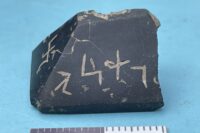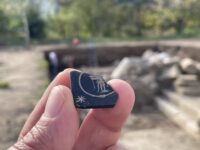 An obsidian amulet of Egyptian origin has been unearthed in the Roman-era remains of the ancient city of Amastris in northern Turkey. It was discovered in a Roman structure built out of marble in the 2nd century A.D. The amulet is the only artifact recovered from the structure.
An obsidian amulet of Egyptian origin has been unearthed in the Roman-era remains of the ancient city of Amastris in northern Turkey. It was discovered in a Roman structure built out of marble in the 2nd century A.D. The amulet is the only artifact recovered from the structure.
The amulet is a pyramidal stamp seal with a square base. it is two centimeters (.78 inches) high with (.35 inches). The sides are carved with letters in demotic script. The base is incised with a figure of the Egyptian god Bes.
 Bes was unusual in the ancient Egyptian pantheon because images of him appear in private homes, not just in religious and funerary contexts. He was the protector of the household, warding off evil spirits and paying particular attention to pregnant women and children. Much like an apotropaic figure from Greek mythology, the gorgoneion or head of Medusa, Bes was depicted facing forward with a fierce expression, mouth open and tongue out. This too makes him unusual among his peers in the pantheon as Egyptian deities were mostly depicted in profile.
Bes was unusual in the ancient Egyptian pantheon because images of him appear in private homes, not just in religious and funerary contexts. He was the protector of the household, warding off evil spirits and paying particular attention to pregnant women and children. Much like an apotropaic figure from Greek mythology, the gorgoneion or head of Medusa, Bes was depicted facing forward with a fierce expression, mouth open and tongue out. This too makes him unusual among his peers in the pantheon as Egyptian deities were mostly depicted in profile.
The presence of Bes and the demotic inscriptions identify the object as a talisman carried to protect the owner from any and all manner of ills.
“We see that there is a figure depicting the god Bes, whom we know from the Egyptian religion, depicted with incised lines at the base of the work. On the upper part of the work, we see that there are letter characters and talismanic words from the ancient Egyptian religion called demotic. The letter characters on the work probably represent this meaning of protection. As a kind of talismanic object, we can define it as an object that a person wears to be protected from evil and diseases or in whatever sense he wants to be protected. We can say that it is the only example of its kind found from the Roman layer in Anatolia during excavations,” [Associate professor Fatma Bağdatlı Çam, head of the Archeology Department of the Faculty of Literature at Bartın University] said.
Çam stated that the discovery of the artifact is an important and exciting development for archaeologists.
“We will investigate what this seal means and whether the person wearing it is a priest, a religious official, or whether someone carries it for health and safety purposes. Perhaps we will find out whether a soldier in the legion brought it here (after) his mission in the east.”